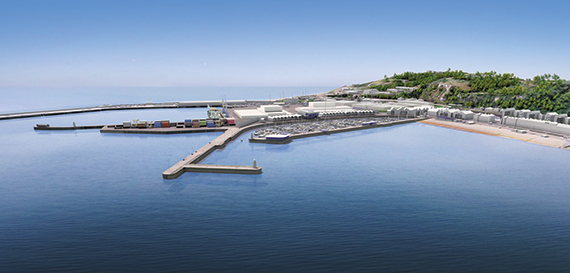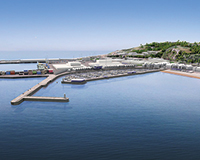 In 2015, Eurotunnel and the Port of Dover handled more than 4m lorries, setting new records in the volume of cross-Channel freight. The Brexit vote may have muddied the waters, but investment to exploit a forecast growth in trade continues regardless.
In 2015, Eurotunnel and the Port of Dover handled more than 4m lorries, setting new records in the volume of cross-Channel freight. The Brexit vote may have muddied the waters, but investment to exploit a forecast growth in trade continues regardless.
“By 2020-21, we expect our freight volumes to grow by 30%,” says John Keefe, Eurotunnel director of public affairs. “The two sides of the Channel are so interdependent when it comes to trade and I cannot see that changing.”
He adds: “Given those trade links, there is real potential to attract more distribution and logistics occupiers. Why transport stock up to the Midlands, only to have to bring it back down the motorway to customers in London? It makes sense to focus closer to the point of entry and locate hubs along the M20.”
Just as Eurotunnel is investing in increased terminal and shuttle capacity, the Port of Dover is also expanding its freight facilities. In 2015, the port handled £119bn of trade and has reported a 30% growth in freight vehicle traffic over the past three years.
Its Dover Western Docks Revival project will incorporate a £120m cargo terminal that will later lead to the development of a logistics park.
Following the referendum vote on 23 June, the port confirmed that the £36m of EU funding it received to support its expansion will not be clawed back. According to a letter released by the port’s chief executive, Tim Waggott, the work will continue as planned and the port remains “very much open for business”.
Dover is not the only port looking to attract logistics and distribution occupiers.
In January, international logistics company GEFCO began importing and storing cars at the Port of Ramsgate for distribution across the UK.
Thanet District Council’s head of maritime and technical, Mike Humber, says: “We want to exploit the cross-Channel freight market. There is significant demand and I cannot see anything challenging that. We now have an aspiration to expand off-site logistics so that occupiers can benefit from our strategic location.”
But can coastal locations challenge the dominance of the golden triangle and persuade occupiers to invest further south?
“The issue ports will always face is that their market is just 180 degrees,” says CBRE director Sam Smith. “That being said, there is a real shortage of space for big sheds and if they can establish a market, they will do well. There is certainly a case to attract more logistics to Kent.”
Up to now, there has not been enough suitable stock available to test demand from occupiers.
Locate in Kent chief executive Paul Wookey says: “We have suffered from a lack of available land, but there are now opportunities to attract added-value businesses that would otherwise have located further up the motorway.”
As well as the prospect of a new logistics park at the Port of Dover, there is potential for employment land around Folkestone as part of the development of a new town at Otterspool, says Wookey.
In the meantime, much of the focus will be on the delivery of Stour Park, Ashford. AXA and DMI Properties received planning permission in May to develop 1.7m sq ft at Sevington, near junction 10 of the M20.
“We are offering units of between 50,000 and 500,000 sq ft on a site that will have access to a new motorway junction,” says DMI director Steve Messenger. “There is real demand for large modern warehouses close to the port.” Kent Wool Growers has already signed for a 50,000 sq ft prelet.
Messenger is undeterred by the referendum result and says the development has attracted interest from the US and Asia. Infrastructure work will begin later this year.
If Stour Park does prove successful, it could help change perceptions of coastal logistics hubs.
Len Rosso, Colliers International’s head of industrial and logistics, says: “The Midlands will remain the focus for logistics and 3PL operations, but coastal locations can provide good spots from which to distribute imports and provide local logistics hubs to serve customers as far up as London.”
Calais cachet
Plans are afoot to transform the Calais coast into a major logistics hub, offering multi-modal transport links across Europe.
The Port of Calais is undergoing an €800m (£678m) expansion to double its capacity and accommodate an anticipated 40% boost in cross-Channel traffic by 2030.
Franck-Edouard Tiberghien, director of development and strategy at Port Boulogne Calais, says: “We handle more than 2.8m lorries a year and forecast strong growth. Despite the Brexit vote, Britain is pragmatic and our trading relationship will go on regardless.”
Much of France’s distribution and logistics activity is focused down the A1 motorway, yet Calais is hoping infrastructure improvements and the enhancement of the port will help it win a bigger slice of the cake.
French developer DCB International is delivering a 400-acre logistics park close to the port and Eurotunnel. The first phase of Calais Premier will deliver two 540,000 sq ft warehouses linked to an integrated rolling motorway terminal.
Nearby, fellow developer Polley Group is about to start work on the first phase of its own 260,000 sq ft warehouse project alongside the A16 Calais-to-Dunkirk motorway.
Polley director Pascal Lecomte says: “There is a great opportunity to attract logistics occupiers to Calais and I predict that at least 50% of occupiers will be from Britain.
“They can keep their stock more cheaply on French soil just 30 minutes from Dover and two hours from London.”
According to Colliers International, prime industrial rents around Calais are around 40% of those in the South East of England and British occupiers wanting greater value and choice may be tempted to extend their search across the Channel.











